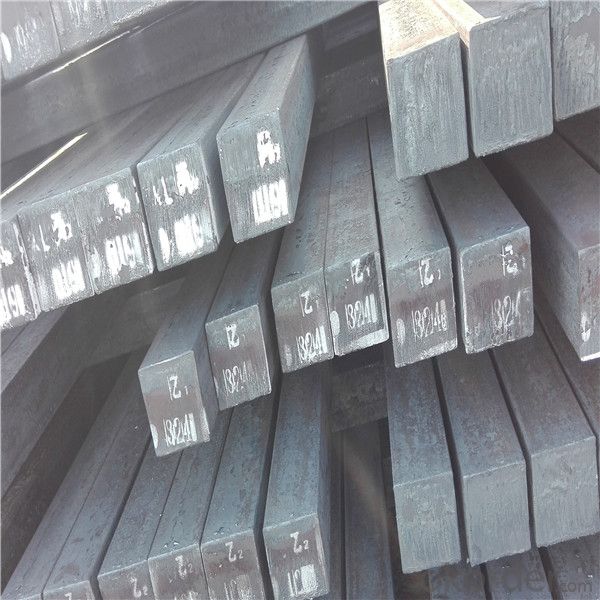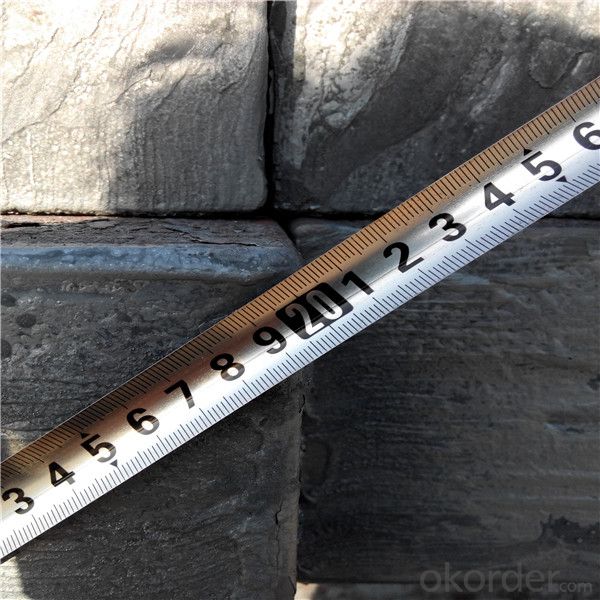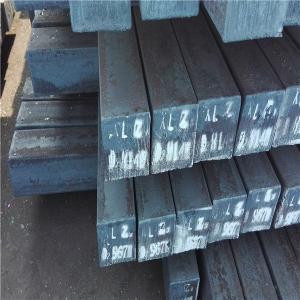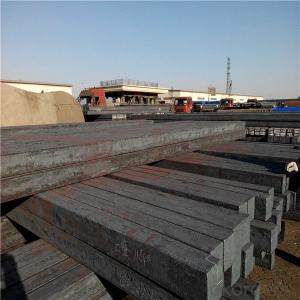Alloy steel billet square prime from china
- Loading Port:
- Guangzhou
- Payment Terms:
- TT OR LC
- Min Order Qty:
- 1000 m.t.
- Supply Capability:
- 31264 m.t./month
OKorder Service Pledge
OKorder Financial Service
You Might Also Like
Item specifice
Steel billet
Steel billets have distinct characteristics as compared with already furnished steel bars and products.
Billets have a specific grain structure, which enables the metal to be processed more intricately. Steel
billets are also known for their malleability and ductility, especially when exposed to varying temperatures
during shaping and molding.
Qaulity:own factory, stable quality
Tolerance: Strictly according to the G/B and JIS standard
Delivery time: within 45 days after receiving the L/C or advanced T/T payment.
Price term: FOB/CIF/ CFR according to clients requirements
Payment terms: 100%Irrevercable L/C at sight or T/T
Gade:
Standard | C(%) | Mn(%) | S(%) | P(%) | Si(%) |
Q195 | ≤0.12 | ≤0.50 | ≤0.040 | ≤0.035 | ≤0.30 |
Q235 | ≤0.20 | ≤1.40 | ≤0.045 | ≤0.045 | ≤0.35 |
Q275 | ≤0.22 | ≤1.50 | ≤0.045 | ≤0.045 | ≤0.35 |
20MnSi | 0.17-0.25 | 1.2-1.6 | ≤ 0.050 | ≤ 0.050 | 0.40-0.80 |
3SP | 0.14-0.22 | 0.40-0.85 | ≤ 0.050 | ≤ 0.040 | 0.05-0.15 |
5SP | 0.28-0.37 | 0.50-1.00 | ≤ 0.050 | ≤ 0.040 | 0.15-0.30 |



Our service :
We have a plant and professional team to provide our best service, from the start of production until the
loading into the vessel, we have a complete quality follow up procedure, to assure our products arrives to the customer with satisfaction. Welcome new and old customers
to contact us for future business relationships! We will give you a surpise price.
Packing :
Within 30 days
1.Standard export package
2.In bundles with steel strips
3.As the requirements of the customers
FAQ:
Q: What is payment terms?
A: FOB 30% T/T IN ADVANCE AS DEPOSIT AND 70% T/T BEFORE SHIPMENT
CIF and CFR 30% T/T IN ADVANCE AS DEPOSIT AND 70% T/T AS THE COPY OF B/L OR L/C AT SIGHT
Q:How to guarantee the quality of the products?
A:We have established the international advanced quality management system,every link from raw material
to final product we have strict quality test;We resolutely put an end to unqualified products flowing into the market.
At the same time, we will provide necessary follow-up service assurance.
Q:How long can we receive the product after purchase?
A :In the purchase of product within three working days, We will arrange the factory delivery as soon as possible.
The pecific time of receiving is related to the state and position of customers.
- Q:What are the safety precautions to be taken while handling steel billets?
- When handling steel billets, there are several safety precautions that should be followed to ensure the well-being of individuals as well as the integrity of the material. Some key safety precautions include: 1. Personal Protective Equipment (PPE): It is essential to wear appropriate PPE such as gloves, safety glasses, and steel-toed boots to protect against potential injuries. Steel billets are heavy and can cause severe harm if dropped or mishandled. 2. Proper Lifting Techniques: When lifting steel billets, it is crucial to use proper lifting techniques, such as bending at the knees and keeping the back straight. This helps prevent strains, sprains, and other musculoskeletal injuries. 3. Adequate Training: Workers should receive proper training on how to handle steel billets safely. This includes understanding the weight and dimensions of the billets, knowing how to move them safely, and being aware of potential hazards. 4. Secure Storage and Transportation: Steel billets should be stored and transported in a secure manner to prevent accidents. They should be properly stacked, secured, and not overloaded to avoid falling or shifting during handling. 5. Clear Communication: In a work environment where multiple individuals are involved in handling steel billets, clear communication is essential. This includes using appropriate signals and verbal communication to coordinate movements and ensure everyone's safety. 6. Inspect Equipment: Before handling steel billets, it is important to inspect the equipment being used, such as cranes, forklifts, or other lifting devices. This helps identify any potential issues or malfunctions that could compromise safety. 7. Regular Maintenance: Regular maintenance of equipment used for handling steel billets is crucial to ensure their proper functioning. This includes inspections, repairs, and replacements as needed. 8. Hazard Identification: Workers should be trained to identify potential hazards associated with handling steel billets, such as sharp edges, hot surfaces, or slippery floors. Identifying and addressing these hazards promptly can prevent accidents and injuries. 9. Ergonomic Considerations: Ergonomic factors should be considered when designing workstations and handling procedures. This includes ensuring proper height and reach distances, providing adequate space for movement, and using tools or equipment that reduce strain on the body. 10. Emergency Response: Lastly, workers should be aware of emergency response procedures in case of accidents or injuries. This includes knowing the location of first aid kits, fire extinguishers, emergency exits, and how to report incidents to supervisors. By following these safety precautions, individuals can mitigate the risks associated with handling steel billets and create a safer work environment.
- Q:How are steel billets used in the production of structural components?
- Steel billets are used in the production of structural components by being heated and molded into desired shapes such as beams, columns, and plates. These billets serve as the starting material, which is then further processed through rolling, forging, or extrusion to create strong and durable structural components used in various industries such as construction, automotive, and aerospace.
- Q:How do steel billets contribute to the energy industry?
- Steel billets play a crucial role in the energy industry by serving as the primary raw material for the manufacturing of various energy-related equipment and infrastructure. Steel billets, which are semi-finished steel products, are used extensively in the construction of power plants, oil and gas pipelines, wind turbines, and other energy infrastructure projects. One of the key applications of steel billets in the energy industry is in the production of power plant components. Steel billets are used to manufacture various parts of power plants, including boilers, turbines, and generators. These components require a high level of strength, durability, and resistance to high temperatures and pressure, which steel billets can provide. By using steel billets, power plant manufacturers can ensure the reliability and longevity of their equipment, contributing to the overall efficiency and stability of the energy generation process. Steel billets are also essential for the construction of oil and gas pipelines. These pipelines are crucial for the transportation of oil, natural gas, and other energy resources from production sites to refineries and end-users. Steel billets are used to manufacture the large-diameter pipes that form the backbone of these pipelines. The strength, toughness, and corrosion resistance of steel billets ensure the integrity and safety of the pipeline infrastructure, minimizing the risk of leaks or failures that could result in energy supply disruptions or environmental damage. In addition, steel billets are utilized in the production of wind turbines, which are a rapidly growing source of renewable energy. The towers and foundations of wind turbines are typically made of steel, and steel billets are used to manufacture these components due to their exceptional strength and load-bearing capabilities. By utilizing steel billets, wind turbine manufacturers can construct tall and sturdy towers that can support the rotor and ensure the efficient conversion of wind energy into electricity. Overall, steel billets contribute significantly to the energy industry by enabling the construction of robust and reliable infrastructure. The strength, durability, and versatility of steel billets make them an ideal material for energy-related projects, helping to ensure the efficient and sustainable generation, transportation, and utilization of energy resources.
- Q:What are the safety precautions when handling steel billets?
- When handling steel billets, it is important to follow several safety precautions to minimize the risk of accidents and injuries. Firstly, it is crucial to wear appropriate personal protective equipment (PPE) such as safety glasses, steel-toed boots, gloves, and a hard hat. Before handling steel billets, ensure that the work area is clear of any obstacles or debris that could cause trips or falls. Additionally, make sure that the billets are stored and stacked properly to prevent them from falling or shifting unexpectedly. When lifting or moving steel billets, be cautious of their weight and size. Use appropriate lifting equipment such as cranes, forklifts, or hoists to avoid strains or musculoskeletal injuries. Always adhere to the weight limits and load capacities of the equipment being used. Maintain a good grip on the billets to prevent them from slipping or falling. Avoid sharp edges or protruding parts that may cause cuts or puncture wounds. If necessary, use protective covers or padding to prevent contact with sharp or jagged edges. Proper communication is essential when handling steel billets. Ensure that there is clear communication between the workers involved in the process to avoid accidents or mishaps. Use hand signals or radios to communicate effectively, especially in noisy environments. Regularly inspect the steel billets for any defects or damage before handling them. Cracks, rust, or any other issues can compromise the structural integrity of the billets and increase the risk of accidents. If any defects are detected, report them to a supervisor and follow the appropriate procedures for handling or disposing of the billets. Lastly, always be aware of your surroundings and the movements of other workers when handling steel billets. Avoid standing or working in the swing radius of lifting equipment or near moving machinery to prevent being struck or crushed. By following these safety precautions, the risk of accidents and injuries while handling steel billets can be significantly reduced, creating a safer work environment.
- Q:What are the potential applications of steel billets in the automotive sector?
- Steel billets have a wide range of potential applications in the automotive sector. One of the key uses of steel billets is in the production of automotive parts and components. These billets can be further processed and shaped into various forms such as rods, bars, and sheets to manufacture critical components like engine parts, chassis, and suspension systems. The strength and durability of steel make it an ideal material for automotive applications. Steel billets can be transformed into high-strength steel alloys, which are known for their excellent mechanical properties, including high tensile strength, hardness, and impact resistance. These properties make steel billets suitable for use in structural components, such as the frame and body of vehicles, providing stability and enhancing passenger safety. Steel billets are also used in the production of engine parts, such as crankshafts, camshafts, and connecting rods. These components require high strength and resistance to wear and fatigue, which steel billets can provide. Additionally, steel billets can be used to manufacture gears, axles, and transmission components, which require excellent mechanical properties to withstand the demanding conditions of the automotive industry. Furthermore, steel billets find application in the manufacturing of suspension systems, including control arms, stabilizer bars, and springs. These components need to withstand heavy loads, vibrations, and impacts while ensuring optimal ride comfort and handling. Steel billets' high strength and toughness make them suitable for these critical suspension components. Moreover, steel billets are also utilized in the production of safety features in automobiles. For instance, they can be used to manufacture reinforced door beams, which enhance the structural integrity of the vehicle and provide protection in the event of a collision. Additionally, steel billets can be employed in the production of seat frames and seatbelt components, ensuring passenger safety and restraint systems. Overall, the potential applications of steel billets in the automotive sector are vast and crucial. Their strength, durability, and excellent mechanical properties make them indispensable for the production of various automotive components, ranging from engine parts to structural elements and safety features.
- Q:What are the main factors affecting the creep resistance of steel billets?
- The main factors affecting the creep resistance of steel billets include the composition of the steel, the temperature at which the billets are exposed, the applied stress, and the microstructure of the steel.
- Q:How do steel billets contribute to the overall noise reduction of a structure?
- Steel billets can contribute to the overall noise reduction of a structure in several ways. Firstly, steel billets are often used in the construction of walls, floors, and ceilings, which are key components in sound insulation. The density and rigidity of steel helps to effectively block and absorb sound waves, preventing them from passing through the structure and reducing noise transmission. Additionally, steel billets can be used to create acoustic panels, which are specifically designed to enhance sound absorption and reduce reverberation within a space. These panels can be strategically placed in areas where noise is a concern, such as in conference rooms, auditoriums, or music studios. By incorporating steel billets into these panels, their acoustic properties are enhanced, resulting in improved noise reduction. Moreover, steel billets can also be utilized in the manufacturing of doors and windows. These elements are often sources of sound leakage due to their susceptibility to vibrations and poor sealing. By using steel billets in the construction of doors and windows, their strength and stability are increased, reducing the amount of sound that can pass through them. Additionally, the use of steel frames and gaskets can create a tighter seal, further minimizing noise infiltration. In summary, steel billets contribute to the overall noise reduction of a structure by providing the necessary density, rigidity, and acoustic properties to effectively block, absorb, and reduce sound transmission. Whether used in construction materials, acoustic panels, or doors and windows, steel billets play a significant role in creating a quieter and more comfortable environment.
- Q:Can steel billets be used for structural applications?
- Yes, steel billets can be used for structural applications. Steel billets are semi-finished products commonly used in the manufacturing of various structural components such as beams, columns, and rods. These billets can be further processed through rolling or forging to create the desired shapes and sizes required for structural applications. The high strength and durability of steel make it a popular choice for constructing buildings, bridges, and other infrastructure projects.
- Q:Can steel billets be used in the manufacturing of machinery?
- Yes, steel billets can be used in the manufacturing of machinery. Steel billets are semi-finished products that can be further processed into various shapes and sizes for different applications. In machinery manufacturing, steel billets are often used as raw materials to produce components such as gears, shafts, and structural frames. The high strength and durability of steel make it an ideal choice for machinery that requires robust construction and reliable performance.
- Q:What are the main factors that affect the international trade of steel billets?
- There are several main factors that affect the international trade of steel billets. 1. Economic factors: The state of the global economy plays a crucial role in determining the demand and supply of steel billets. Economic growth and stability in major importing and exporting countries impact the overall demand for steel products, including billets. A strong economy usually leads to increased construction and infrastructure projects, which in turn boosts the demand for steel billets. 2. Government policies and regulations: Trade policies, import/export regulations, and tariffs imposed by governments significantly impact the international trade of steel billets. Governments can impose trade barriers, such as tariffs and quotas, to protect domestic steel industries or address national security concerns. These policies can directly affect the competitiveness and cost of steel billets in the international market. 3. Currency exchange rates: Exchange rates between currencies can influence the competitiveness of steel billets in international markets. If the currency of a steel billet exporting country strengthens against the currency of the importing country, it becomes more expensive for the importing country to purchase steel billets. This can impact the demand and prices of steel billets in international trade. 4. Technological advancements: Technological advancements in steel production and manufacturing processes can affect the international trade of steel billets. Improvements in production efficiency, quality control, and the development of new steel grades can give certain countries a competitive advantage in the global market. Innovative manufacturing techniques can lead to cost reductions and improved product quality, making steel billets more attractive to international buyers. 5. Environmental and sustainability considerations: Increasingly, environmental regulations and sustainability concerns are becoming important factors in international trade. Countries with stricter environmental regulations may require steel billet exporters to meet certain standards or obtain certifications, which can affect their competitiveness in the international market. Additionally, the demand for sustainable and low-carbon steel products is growing, which can influence the trade of steel billets. 6. Political stability and geopolitical factors: Political stability and geopolitical tensions can also impact the international trade of steel billets. Political instability, conflicts, or trade disputes between countries can disrupt supply chains, affect market access, and create uncertainties in the international trade of steel billets. These factors can lead to disruptions in trade flows and impact the prices and availability of steel billets in the global market. Overall, the international trade of steel billets is influenced by a combination of economic, regulatory, technological, environmental, and geopolitical factors. Understanding and monitoring these factors is crucial for stakeholders in the steel industry to navigate the complexities of the global market and make informed decisions.
1. Manufacturer Overview |
|
|---|---|
| Location | |
| Year Established | |
| Annual Output Value | |
| Main Markets | |
| Company Certifications | |
2. Manufacturer Certificates |
|
|---|---|
| a) Certification Name | |
| Range | |
| Reference | |
| Validity Period | |
3. Manufacturer Capability |
|
|---|---|
| a)Trade Capacity | |
| Nearest Port | |
| Export Percentage | |
| No.of Employees in Trade Department | |
| Language Spoken: | |
| b)Factory Information | |
| Factory Size: | |
| No. of Production Lines | |
| Contract Manufacturing | |
| Product Price Range | |
Send your message to us
Alloy steel billet square prime from china
- Loading Port:
- Guangzhou
- Payment Terms:
- TT OR LC
- Min Order Qty:
- 1000 m.t.
- Supply Capability:
- 31264 m.t./month
OKorder Service Pledge
OKorder Financial Service
Similar products
New products
Hot products
Related keywords





























